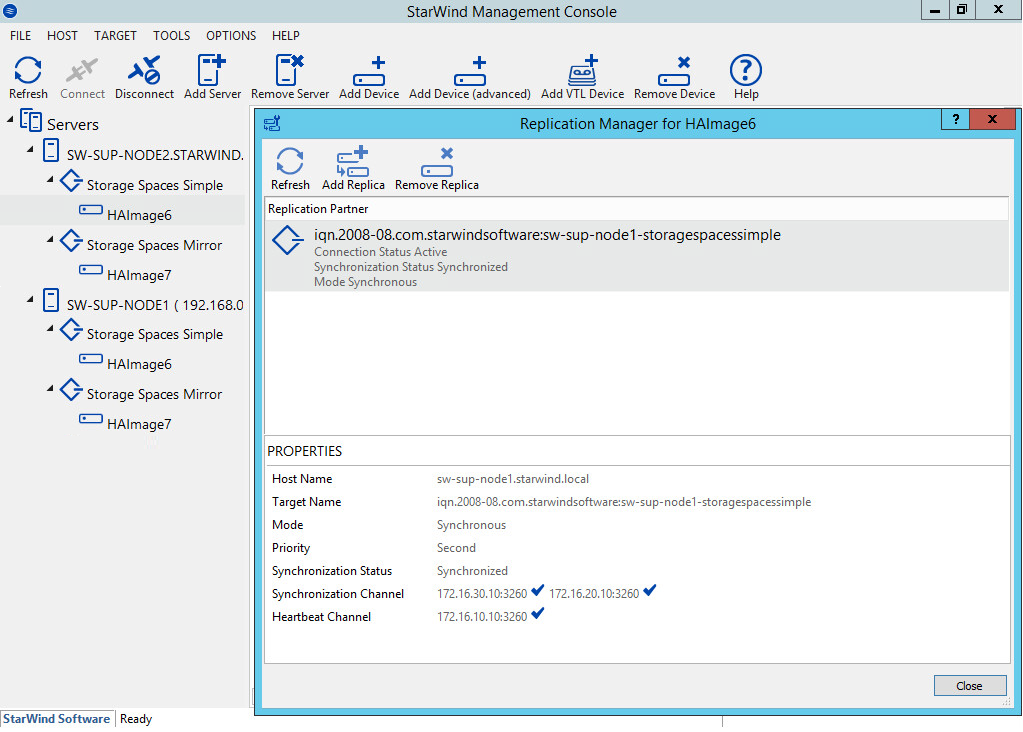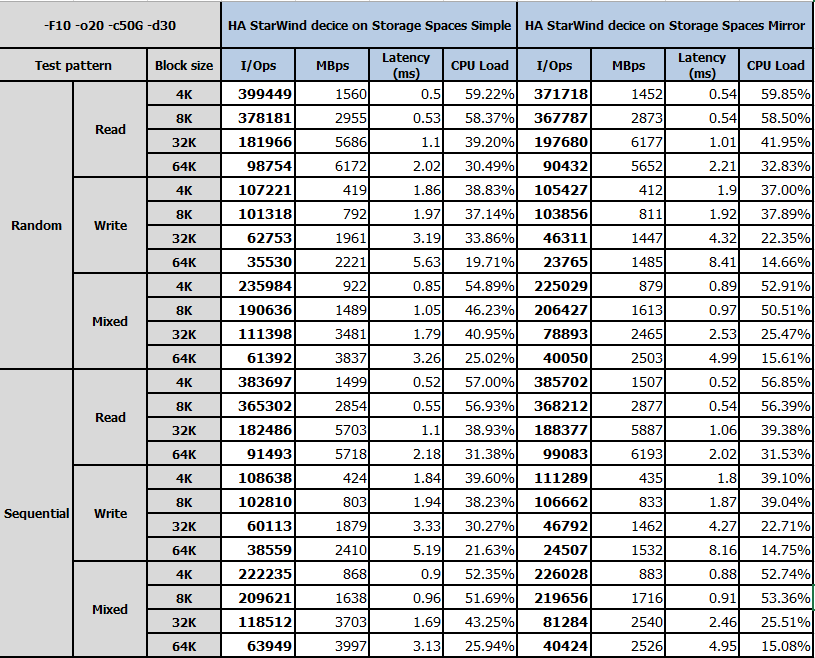Introduction
Previously, we went through the Storage Spaces configuration journey.
The latest step was the creation of the storage pool and the virtual disk.
Today I would like to proceed from that point on and create Highly Available (HA) devices with VSAN from StarWind on Storage Spaces as an underlying storage. The main goal of this post is to run the performance tests of StarWind Highly Available (HA) devices located on Storage Spaces created in different ways (Simple and Mirror). StarWind HA devices will be mirrored between two hosts via a 40Gbps synchronization channel.
Hosts configuration
For the performance evaluation, I have used two hosts with the following hardware:
- OEM PowerEdge R730xd 2 SR
- Intel Xeon E5-2640 v4 2.4GHz, 25M Cache, 8.0GT/s QPI, Turbo, HT, 10C/20T (90W) Max Mem 2133MHz x 2
- 4x32GB RDIMM, 2400MT/s, Dual Rank, x4 Data Width x4
- 8*800 GB Solid State Drive SATA Mix Use 6Gbps 512n 2.5in Hot-plug Drive, 3.5 HYB CARR, Hawk-M4E
- 2*2TB 7.2K RPM NLSAS 512n 3.5in Hot-plug Hard Drive
- 2*2TB 7.2K RPM NLSAS 12Gbps 512n 3.5in Internal Bay Hard Drive
- Mellanox Connect X3 Dual Port 40Gb Direct Attach (one port for synchronization and the other one for iSCSI).
Each host has got Windows Server 2016 Standard and StarWind VSAN installed. Both 40 Gbps network interfaces on each host are used for Synchronization and iSCSI/StarWind heartbeat and are connected directly, as shown in the environment diagram below.
StarWind devices are connected using Microsoft iSCSI initiator via the loopback (127.0.0.1) interface on the local host and via the iSCSI interface (40 Gbps) from the partner host.
Benchmark testing
I’ve configured storage pools in the same way as described in the previous post. I’ve used PowerShell for creating them.
To begin with, I’ve created two StarWind HA devices, which we are going to benchmark on different types of Storage Spaces – Simple and Mirror. While experimenting, I’ve used StarWind HA devices based on image files, each of them having 200GB volume without any type of caching configured.
The quick start guide for creating an HA device with Starwind VSAN can be found at here: https://www.starwindsoftware.com/quick-start-guide-creating-ha-device-with-starwind-virtual-san
StarWind Management Console with the HA devices created is shown in the picture below.
The measurements were performed using the Diskspd utility by Microsoft with the following parameters:
Number of threads -F10
Number of outstanding I/O requests per target per thread -o20
Size of the test file -c50G
Duration of the measurement period in seconds -d30
Diskspd utility can be downloaded here: https://gallery.technet.microsoft.com/DiskSpd-a-robust-storage-6cd2f223
During the examination, I’ve used a 50GB test file, which was sufficient for proper benchmarking.
Below you can find the results for StarWind HA devices which are located on the Simple and Mirror Storage Spaces. The table shows extended outcomes for random/sequential read and write operations as well as mixed operations (30% writes and 70% reads).
Conclusion
As expected, StarWind HA device on Storage Spaces Simple got better performance results than the one on Storage Spaces Mirror. This can be explained by the fact that Storage Spaces Simple is faster by design.
Using Storage Spaces with StarWind VSAN allows us reaching about 400,000 IOPS on 4K and 8K Random and Sequential Read patterns. Random and Sequential Writes rise up over 100,000 IOPS on the 4K pattern.
At present, this looks to be sufficient for most environments out there.
Testing and comparing the performance of your Local and Shared Storage





